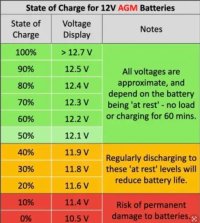Lequimper
VIP Member
In a few weeks we will be proud but very newbie owners of a California Ocean. Unfortunately we don’t have space to store it at home, so it will be kept securely at a local outdoor CASSOA site. This will make things a little more tricky, especially with battery care.
We anticipate taking the van out for a drive at least every other weekend and for an overnight stay further afield (on hook-up) at least monthly. Longer trips in the summer.
So, what are your top tips for keeping the leisure battery in decent condition through the year (and indeed the main battery) when it’s sat there all on its lonesome for the times in between trips?
Might having a solar panel installed on the roof help at all?
TIA.
We anticipate taking the van out for a drive at least every other weekend and for an overnight stay further afield (on hook-up) at least monthly. Longer trips in the summer.
So, what are your top tips for keeping the leisure battery in decent condition through the year (and indeed the main battery) when it’s sat there all on its lonesome for the times in between trips?
Might having a solar panel installed on the roof help at all?
TIA.














